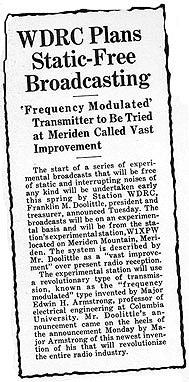 |
1936
- Doolittle received permission to operate W1XSL, one
of twelve "Apex" AM high frequency stations on an
experimental basis. It was built on the west peak of Meriden
Mountain and operated at 40,300kc (40.3mc) with 1kw of power.
January
16, 1939 - Major Edwin H. Armstrong, professor
of electrical engineering at Columbia University, announced
the invention of frequency modulated radio.
January
17, 1939 - Doolittle announced a series of experimental
broadcasts "free of static and interrupting noises of any
kind" would be undertaken in the spring. His station would
use the frequency modulated type of transmission pioneered
by Armstrong at Columbia University.
May
13, 1939 - At a cost of $20,000, Doolittle put
America's first commercial FM station on the air at 2:39PM,
as experimental station W1XPW. It was on the air from
3PM-12M, airing classical music, and later simulcasting WDRC.
January,
1940 - To demonstrate the capabilities of FM, music
and speech are broadcast over an FM station in Yonkers, NY.
Major Armstrong's W2XMN in Alpine, NJ picks it up and relays
it to W1XOJ in Paxton, MA., which relays it to W1XER atop
Mt. Washington, NH. From there the signal was rebroadcast
by short wave to a Yankee
Network outpost near Boston, and back to Yonkers.
|

